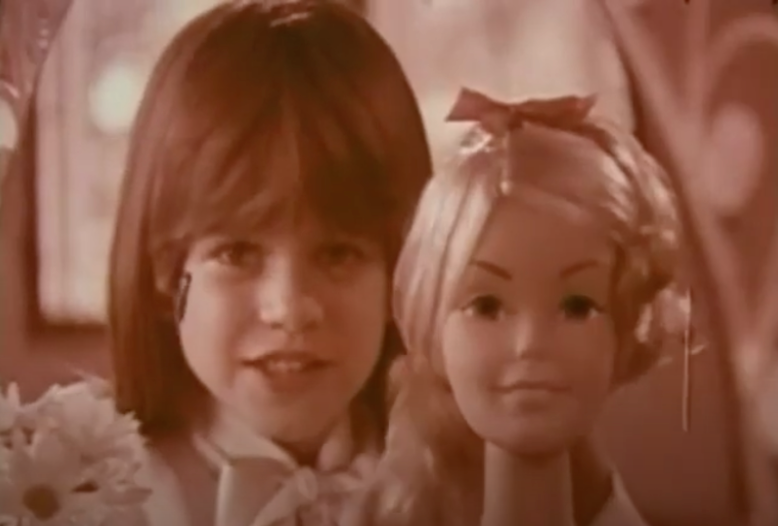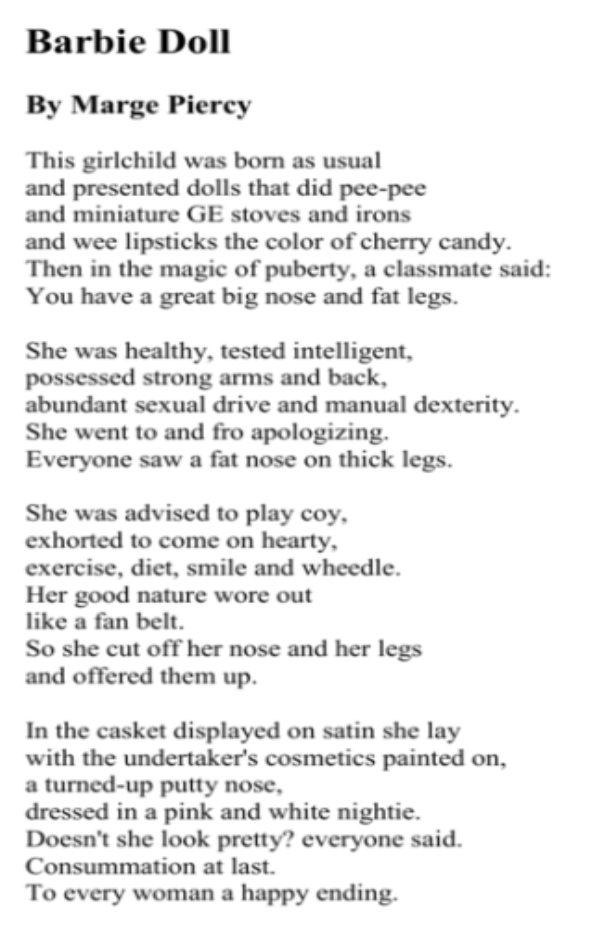Barbie Fashion Face Toy Commercial 1977

Screenshot from Barbie Fashion Face Toy Commercial, 1977. Depicted is a young white girl playing dress-up with a Barbie.
White women who didn’t have the same European features as the women on the covers of Vogue magazine were discriminated against. The “Fashion Face Toy” commercial from 1977 advertised the popular Barbie doll brand. The video stars a young white girl with defined, dainty features and straight hair, who says “let’s get you beautiful, Barbie” at the start of the commercial. This indicates that Barbie, a character that was inherently blonde, symmetrical, and conventionally attractive, is still not beautiful enough in her natural state. The girl in the commercial proceeds to apply eyeshadow and lipstick on Barbie, curl her blonde hair, and dress her up with jewelry. This further promotes commercial interests by teaching women that they need external products to make them “beautiful” because their natural faces, natural hair styles, and the clothes they are comfortable in are not feminine enough. The girl in the video later invites her friends over to see Barbie dressed up, and once they arrive they tell the Barbie doll that she is beautiful. By having the girl dress Barbie up for the sole purpose of seeking approval from her friends, the commercial is teaching women that the desire to please others should drive their actions. This creates a culture where people seek external validation and conform to standards of people in order to do so.

A typed transcript of “Barbie Doll” poem by feminist Marge Piercy, published in 1971. The poem originally appeared in an issue of Off Our Backs, a periodical by radical feminists.
In feminist Marge Piercy’s poem Barbie Doll, written in 1971, she describes how these Barbie standards affected her while growing up as a white woman. She opens the poem by describing how at one point Barbie was simply a doll “that did pee pee.” Barbie on its own was not problematic or a source of insecurity until “a classmate said: You have a great big nose and fat legs.” The comment undermined the subject’s important qualities–she was “healthy, tested intelligent / possessed strong arms and back” yet she had different features than Barbie and was deemed not enough. She was “advised to be coy, / exhorted to come on hearty / exercise, diet, smile and wheedle”––essentially to devote her existence to being the perfect object and to live her life in accordance with the patriarchy that wants to make her small. In order to do so, she metaphorically “cut off her nose and her legs.” This act killed her, and what was left of her was placed “in the casket displayed on satin” for others to see. Her lifeless, pampered body only then warranted “doesn’t she look pretty?” as a reaction. This is commentary on how society teaches women that their life goal should be to attain beauty, and how dying for such a cause is deemed honorable. The irony in the line “To every woman a happy ending” reflects how women in the end either chose to conform, and as a result lose a part of themselves, or “die” trying.
Works Cited
Barbie Fashion Face Toy Commercial 1977. Youtube, uploaded by Retropolis Channel, 17 Dec. 2018, https://www.youtube.com/watch?v=41uAvRn96Tg.
Piercy, Marge. “Barbie-Doll.” Off Our Backs, vol. 1, no. 19, off our backs, inc., 1971, p. 7, http://www.jstor.org/stable/25771220.
